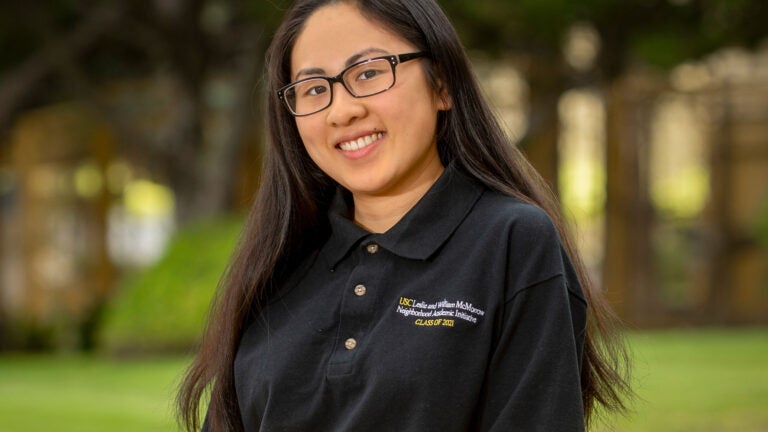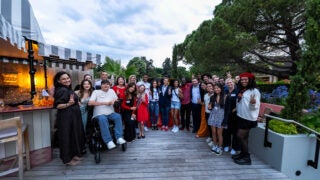
NAI graduate Tracy Nguyen was an early admit to Johns Hopkins University. (USC Photo/Gus Ruelas)
A seven-year journey ends for the USC Neighborhood Academic Initiative’s most accomplished class
Tracy Nguyen, who is headed to Johns Hopkins University, is one of the 83 graduating high school seniors who will be attending college this fall — a perfect 100% of the class.
At a virtual gala on Saturday, the USC Leslie and William McMorrow Neighborhood Academic Initiative celebrated the culmination of a seven-year journey for its Class of 2021, one that managed to surpass the high bar of accomplishments set by previous classes despite the challenges of a global pandemic.
“You did it, and you did it beautifully well in this very challenging year when all classes were remote,” said President Carol L. Folt. “You and your families and families across the nation and the world were stressed to the max, but you kept your dreams on track.”
It was a historic year for the Neighborhood Academic Initiative, or NAI, as its 83 graduating scholars made up the second-biggest class in the history of the program. This year, NAI scholars received 63 letters of admission into USC, the most ever and nearly double last year’s previous high.
“We are also celebrating a tremendous feat: 100%, all 83 graduating seniors will be attending college this fall,” said Sam Garrison, senior vice president of university relations. “While the road leads to USC for many, NAI also opens the door for other college opportunities.”
USC NAI graduates received multiple letters of admission from colleges across California and around the country. Many in the program will be first-generation students, and some faced the difficult decision of leaving home.
Tracy Nguyen was an early admit to Johns Hopkins University. She credits the initiative for getting her outside of her comfort zone and helping her parents support her dreams, even if the dream will take her nearly 3,000 miles away, to Maryland.
“My whole life I pictured myself going to a UC or USC. I never imagined myself leaving,” she said. “I’m very close to my family. All my cousins who went before me stayed close to home; I never knew anyone who went outside of that bubble.”
She added that the support of the program encouraged her to expand her network and take advantage of mentorship programs, which proved vital during the application and decision-making process.
USC NAI graduates exemplify the program’s community spirit
Saturday’s celebration was also an opportunity to highlight the impact the NAI program had in the community and the challenges it helped its scholars overcome during the pandemic.
“During the past year of this unprecedented pandemic, the NAI team has delivered food and personal protective equipment, registered families for testing and vaccinations, and connected students with school supplies, laptops and mobile hot spots,” Garrison said. “The pandemic has underscored the collective power of the NAI community’s strength and spirit.”
The academic impact the program has on the community can once again be seen at Foshay Learning Center in South Los Angeles, the public school that continually sends the most students to USC. The co-valedictorians and the salutatorian from Foshay are USC NAI scholars, and all three will be attending USC in the fall.
While the road leads to USC for many, NAI also opens the door for other college opportunities.
Sam Garrison
“What does it really mean for a university to be a good neighbor?” said Pedro Noguera, the night’s keynote speaker and dean of the USC Rossier School of Education. “NAI is showing it means working with schools, working with students like yourselves and expanding opportunities so that education can continue to be a pathway to a better life.”
In the past 24 years, more than 1,300 students have graduated from the Neighborhood Academic Initiative. This year, USC NAI graduates and their families were treated to a dinner from local restaurants in the South Los Angeles and Eastside area, supporting the Trojan Shop Local movement.



